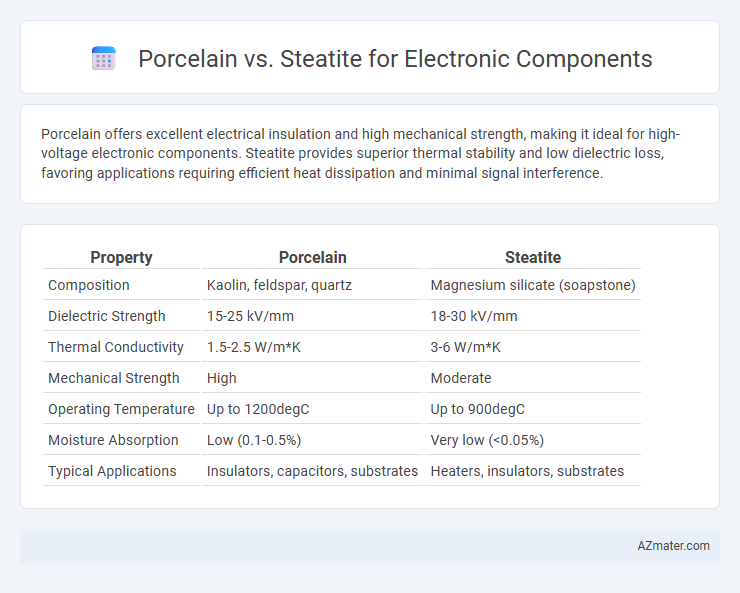Porcelain offers excellent electrical insulation and high mechanical strength, making it ideal for high-voltage electronic components. Steatite provides superior thermal stability and low dielectric loss, favoring applications requiring efficient heat dissipation and minimal signal interference.
Table of Comparison
| Property | Porcelain | Steatite |
|---|---|---|
| Composition | Kaolin, feldspar, quartz | Magnesium silicate (soapstone) |
| Dielectric Strength | 15-25 kV/mm | 18-30 kV/mm |
| Thermal Conductivity | 1.5-2.5 W/m*K | 3-6 W/m*K |
| Mechanical Strength | High | Moderate |
| Operating Temperature | Up to 1200degC | Up to 900degC |
| Moisture Absorption | Low (0.1-0.5%) | Very low (<0.05%) |
| Typical Applications | Insulators, capacitors, substrates | Heaters, insulators, substrates |
Introduction to Porcelain and Steatite in Electronics
Porcelain and steatite are widely used materials in electronic components due to their excellent insulating properties and thermal stability. Porcelain, a ceramic material composed mainly of kaolin, feldspar, and quartz, offers high mechanical strength and resistance to high temperatures, making it ideal for insulators in high-voltage applications. Steatite, primarily made of magnesium silicate, provides superior dielectric properties and low loss characteristics, commonly employed in capacitors and substrates for microwave circuits.
Material Composition: Porcelain vs Steatite
Porcelain is primarily composed of kaolin, feldspar, and quartz, offering excellent electrical insulation and mechanical strength for electronic components. Steatite, made mainly from magnesium silicate (talc), provides superior thermal shock resistance and higher dielectric strength, making it ideal for high-voltage applications. The distinct mineral compositions influence their performance, with porcelain excelling in structural durability and steatite in thermal and electrical insulation properties.
Electrical Insulation Properties
Porcelain exhibits excellent electrical insulation properties due to its high dielectric strength and resistance to moisture, making it a preferred material for high-voltage applications. Steatite, composed mainly of magnesium silicate, offers superior machinability and thermal stability but generally possesses lower dielectric strength than porcelain. Both materials provide reliable insulation, yet porcelain's enhanced resistance to electrical breakdown and environmental degradation positions it as the superior insulator in demanding electronic component applications.
Thermal Performance Comparison
Porcelain offers superior thermal resistance withstanding temperatures up to 1600degC, making it ideal for high-temperature electronic components. Steatite, while more cost-effective, operates effectively up to around 1000degC and provides excellent thermal shock resistance but lower thermal conductivity than porcelain. Choosing between them depends on the thermal demands of the application, with porcelain favored for extreme heat and steatite suitable for moderate thermal environments.
Mechanical Strength and Durability
Porcelain exhibits high mechanical strength with excellent resistance to wear and thermal shock, making it suitable for heavy-duty electronic components in harsh environments. Steatite offers superior durability due to its excellent electrical insulation properties and resistance to moisture, but it has comparatively lower mechanical strength than porcelain. The choice between porcelain and steatite depends on the specific application requirements for mechanical resilience versus long-term durability in electronic components.
Manufacturing Processes and Cost
Porcelain and steatite differ significantly in manufacturing processes and cost for electronic components. Porcelain requires high-temperature firing above 1200degC, involving complex ceramic forming and glazing steps, leading to long production cycles and higher energy consumption. Steatite, primarily composed of magnesium silicate, is processed at lower temperatures around 900-1000degC, allowing faster sintering and reduced manufacturing costs, making it a more economical choice for high-volume electronic insulators.
Applications in Electronic Components
Porcelain and steatite serve distinct roles in electronic components due to their unique dielectric properties and thermal stability. Porcelain, known for its high mechanical strength and excellent insulation, is widely used in high-voltage insulators, capacitors, and substrates where durability under stress is critical. Steatite, favored for its low dielectric loss and high temperature resistance, is commonly applied in electronic insulators, resistors, and microwave devices requiring precise thermal and electrical performance.
Advantages of Using Porcelain
Porcelain offers superior electrical insulation and high dielectric strength, making it ideal for electronic components exposed to high voltages. Its excellent thermal stability and resistance to moisture ensure consistent performance in harsh environments, reducing the risk of component failure. Porcelain's mechanical strength and resistance to chemical corrosion further enhance durability and longevity in electronic applications.
Benefits of Steatite in Electronics
Steatite offers superior electrical insulation and excellent thermal stability, making it highly beneficial for electronic components requiring reliable performance under high temperatures. Its low dielectric loss ensures minimal signal interference, improving the efficiency of electronic circuits. The material's mechanical strength and resistance to moisture also enhance durability and longevity in harsh operating environments.
Choosing the Right Material: Porcelain or Steatite?
Porcelain offers superior mechanical strength and high dielectric resistance, making it ideal for high-voltage insulators and electronic components requiring durable insulation. Steatite, composed primarily of magnesium silicate, provides excellent thermal shock resistance and lower dielectric loss at high frequencies, suitable for precision electronic applications and RF modules. Choosing between porcelain and steatite depends on specific electronic component requirements such as voltage rating, thermal stability, and frequency response characteristics.

Infographic: Porcelain vs Steatite for Electronic Component
 azmater.com
azmater.com